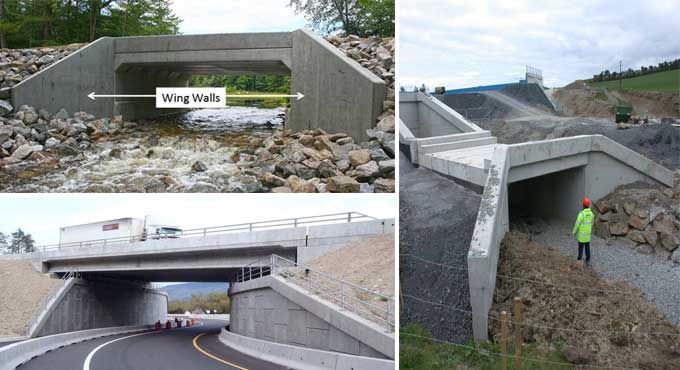
An Explanation of the types of Wing Walls
Whenever retaining walls surround abutments, they are called "wing walls." In some cases, the wing walls are separate from the abutment walls. As the soil and fill support the roadway and near the embankment, the wing walls can be recreated at various angles or at right angles to the abutments. In most cases, wing walls and abutments are constructed simultaneously.
Define Wing Walls: Wing walls on abutments are primarily used to prevent carriageway settlement by maintaining backfill behind the abutment wall. Upon compacting the backfill material and containing the soil, there is a risk of high lateral earth pressure.
How to design Wing Walls
In the design of wing walls, the following loads must be considered: earth pressures from backfill, surcharges from truck weights, and hydrostatic loads from saturated sod.
Wall structural elements are generally designed to resist at rest earth pressure, while wing wall stability is generally designed to resist active earth pressure. It is the principle that structural elements and the force method should be designed to resist initial at rest pressures.
In either case, as the wall shifts-either by rotating or sliding the pressure will decrease. Accordingly, if the wall is designed to resist active earth pressure, it will stabilize if it moves under rest pressure.
Wing Walls Types
Free Standing Wing Walls: It is designed as a nominal cantilever retaining wall and is independent of the main abutment. Despite the abutment and wing walls settling and tilting independently, this is very likely to occur. For these reasons, it is important to carefully plan the construction joints between the two structures so as to both allow for movement between them and to cover them.
Workflow
Regardless of the deck's skew angle, the wing walls can be placed parallel to the abutment wall, which allows the backfill to be compacted easily and eliminates any design issues. In addition to holding backfill and parapet fencing, wing walls can be formed to follow the over-road path.
Positioning the backfill material will be more difficult in this configuration, and sideways movement will be restricted, resulting in higher earth pressure. Because of this, this type of design would be more expensive to build. Wing walls can be tapered in height and spread out at 45 degrees from the abutment.
Cantilevered Wing Walls: An alternative method for paralleling wing walls with the over-road is the use of horizontally cantilevered wings. Generally, this type of construction will work up to 12 meters from the abutment, with careful planning required at the intersection between wings and abutments.
It may be contested to pack the backfill around the wings, even though the building's base provides for it to settle as one unit. When designing this rigid construction, earth pressure should be considered even when it is negligible, since this type of rigid construction sustains high earth pressures.
Using this type of abutment and wing wall structure, a 2D structure can be constructed. Despite its popularity, the meter strip assumption may not always be appropriate as the base for a design.
Workflow
It is likely that an overall reduction in steel requirements can be achieved if the wings are utilized to their full potential.
Abutment walls' stability and bending moments are greatly influenced by the wing wall's self weight, so this consideration must be taken into account. As horizontal stresses increase on the wings, they are transferred over the abutment wall and are transferred into the corners of the abutment.
It is possible to develop vertical torsion blocks between the corner splays of abutments and wing walls in order to keep the high torsionally moments caused by wing wall loading.


